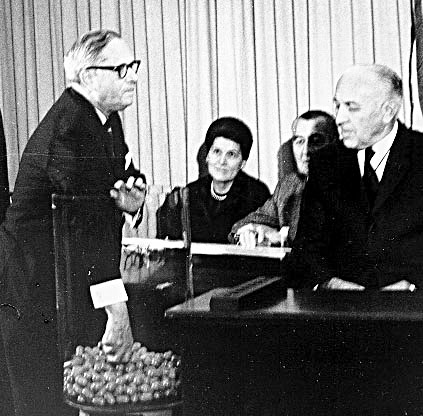
Congressman Alexander Pirnie (R-NY) draws the first capsule
Concerned about the Draft? At Students for a Democratic Society, so are we. Drafting America’s young men into the service of an unjust and immoral war is a violation of SDS’s Port Huaron Statement and the most fundamental American principles.
So it’s important that you know how the draft works if and when your lottery number is drawn. The first lottery drawing was held on December 1, 1969. There were 366 blue plastic capsules containing birth dates placed in a large glass container and drawn by hand to assign order-of-call numbers to all men within the 18-26 age range specified in Selective Service law. The first capsule – drawn by Congressman Alexander Pirnie (R-NY) of the House Armed Services Committee – contained the date September 14, so all men born on September 14 in any year between 1944 and 1950 were assigned lottery number 1. The drawing continued until all days of the year had been paired with sequence numbers.
There are several draft classifications, but here are some of the most common:
Class I-A: Registrant available for military service
Class I-A-O: Conscientious objector registrant available for noncombatant military service only.
Class I-D: Qualified member of reserve component, or student taking military training, including ROTC and accepted aviation cadet applicant.
Class I-W: Conscientious objector performing civilian work contributing to the maintenance of national health, safety, or interest, or who has completed such work.
Class III-A: Extreme hardship deferment, or registrant with a child.
Class IV-F: Registrant not qualified for any military service.
Class V-A: Registrant over the age of liability for military service.
We believe that all SDS members are conscientious objectors to this immoral war, and we encourage any student who is drafted to plead with their local review board. Here are some common questions about the draft and Conscientious Objector (CO) status:
Question: I’ve been called up. What happens now?
Answer: Registrants are ordered to report for a physical, mental, and moral evaluation at a Military Entrance Processing Station to determine whether they are fit for military service. Once he is notified of the results of the evaluation, a registrant will be given 10 days to file a claim for exemption, postponement, or deferment. It is at this time that you would file for CO status.
View an ‘Order to Report for Armed Forces Physical Examination’
Question: What is a conscientious objector?
Answer: One who is opposed to serving in the armed forces or bearing arms on the grounds of moral or religious principles.
Question: Who qualifies as a conscientious objector?
Answer: For some, the beliefs that qualify a person as a conscientious objector may be religious in nature, but they can also be ethical or moral in nature. In United States v. Seeger (1965), the Court held that a registrant was simply required to demonstrate:
“A sincere and meaningful belief which occupies in the life of its possessor a place parallel to that filled by the God of those admittedly qualifying for the exemption comes within the statutory definition.”
However, the government does not consider objections based on political grounds to be valid, nor will they accept arguments of self-interest or expedience. Normally, the review board will take one’s life prior to a claim of CO status into consideration when making their decision, with the expectation that previous actions will reflect their objections to military service or armed conflict.
Question: I’ve filed for an exemption or deferment. What happens now?
Answer: Local and Appeal Boards all over the country are hearing registrant requests for exemptions. They will investigate your claims of CO status and ask questions to determine the validity of your claims. Individuals who are deemed fit for service will be issued induction orders at this time, and are required to report for induction in 10 days. Individuals who successfully prove their CO status will be assigned to alternative service.
View an ‘Order to Report for Induction’
Question: What are my options?
Answer: Once you’ve proven your CO status, you’ll be assigned to alternative service. The type of service will depend greatly on the nature of your CO status. If you are opposed to all armed service, you’ll be assigned to alternative service outside the military. The Selective Service works with a variety of employers, but the work must be deemed to make a meaningful contribution to the maintenance of the national health, safety, and interest. This might involve jobs in conservation, education or health care. The length of your service will be equivalent to that of military service. CO’s who are opposed to armed conflict might be assigned noncombatant work within the US military.
Question: What if I can’t prove CO status. What are other ways to serve that will keep me out of Vietnam?
Answer: Enlistees in the Navy, Air Force, or Coast Guard are unlikely to see action in Vietnam, given the nature of jungle warfare. However, potential enlistees should be warned that these branches have far more stringent enlistment standards than the Army. Another option is to join your local National Guard Unit. Remaining a student does not guarantee you an exemption, and bear in mind that while divinity students are exempt from the draft, while graduating seniors and first-year graduate students no longer enjoy an exemption.
We at the SDS are committed to helping you pursue all means necessary to avoid participation in this immoral war. If you have any further questions, or would like to consult with an SDS member, we urge you to reach out to your local chapter, or contact the SDS national organization at sdsstudent@gmail.com.
